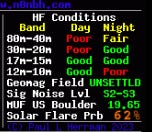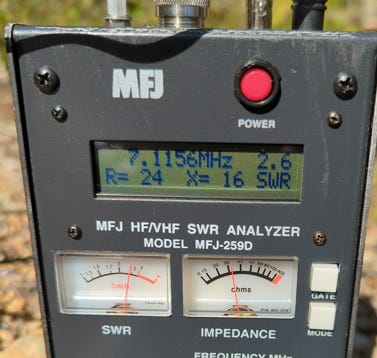Antenna field testing: W3EPD inverted L with MFJ 16010 longwire tuner
Antenna Field Testing 5/12/23
With the weather in the not-too-hot to be outside phase of spring, I decided to get outdoors and gain some real world experience with some new gear and antennas I have been working on. Disclaimer: the purpose of this post is not to convince you that you should use a certain item or antenna, but if anything to convince you that you should get outside and test equipment in the most robust manner you can. I learn (or re-learn) every time I get out, and failure is a sage instructor to those willing to listen.
The bands were not in great shape, and recent experience on evening nets indicated that I could expect significant fluctuation and fading as a baseline.
The first order of business was to test out a MFJ 16010 that I had recently acquired.
This nearly pocket sized L-network tuner is designed for random wire antennas, which fit well with my desire to test a W3EDP antenna. With a 84' radiator set up as an inverted L and a 17' counterpoise, this non-resonant multiband antenna has found favor with SOTA & QRP enthusiasts, so it seemed to have potential for use with my Xeigu X6100 radio.
Initial setup was simple enough, however I quickly encountered my first challenge when the weight of the L's long leg wanted to pull the short leg up through the insulator, along with the tuner! My first attempt using a prussik made from bank line failed to hold the wire due to its slick surface, however a piece of duct tape wrapped around the wire and lightly nailed to the support tree seemed to provide enough hold to keep it down where it should be. The second challenge was the weight of the wire. With over 50' of downward sloping horizontal antenna, the bend of the L was up at 15' off the ground, however a good portion of the long leg was only 5-6' in height. For a first attempt I decided not to let the great be the enemy of the good and decided to get started on testing.
Plugging in the analyzer I dialed up the digital end of the 20 meter band.
The 16010 was able to tune down to 1.5:1, a very usable match although certainly not perfect.
Time for 40 meter.
The first thing to mention is that 40 meter had a very LOW impedance. The nice thing about an L network tuner is that to shift from tuning high impedance to low you just swap the antenna over to the transmitter side and the transmitter over to the antenna side. The L network doesn't mind if you go in the out door (insert pun here)! On the other hand 2.6:1, while well within range for the X6100's internal tuner, forces me to USE the internal tuner, which was not my goal.
Let's try 80.
Back to high impedance on 80, but again about 2.5:1 on the digital portion of the band.
For actual testing I tuned back to 40 meter, fired up the laptop and the X6100, and tuned to the main JS8CALL frequency (7.078). Three heartbeats were sent about a minute apart, then I waited a few minutes and checked PSK Reporter.
I could have asked for more, but with the conditions and putting out only 5 watts, I was pleasantly surprised.
At this point I decided that a baseline comparison was needed. My home station is an Icom 7300 and a 150' inverted V doublet with it's center at 50' AGL. I am very happy with my home station, and can frequently relay stations into nets that NCS cannot hear. So I fired it up and dialed the power back until I had about 5 watts going out for the same 3 heartbeats.
Well those stations look familiar...
Let's crank up the power to 100 watts for another set of heartbeats.
At this point it's fair to point out that in no way am I claiming that a Chinese 5 watt radio with a W3EPD antenna outperforms an Icom 7300 with a large antenna. From the 1st transmissions to the last about 2 hours had elapsed, so the conditions are not the same. It is fair to say however that I plan on testing this antenna set up again, and that it could evolve into a fair field antenna for camping and portable operation.
AAR:
Sustain:
- Antennas were well built. Employing the same techniques with more suitable wire would yield good results.
Improve:
- 12 gauge wire is far too heavy for portable antennas. I had a bunch of it lying around and it was the right price (free) but I need to invest in some stealth wire (or similar) for these projects.
- When testing at home, I need to be prepared to shut down quickly and bring up my home station so that I have a good baseline against a known system for comparison. That would have made my analysis of the W3EPD much more useful for future experiments.
73!











